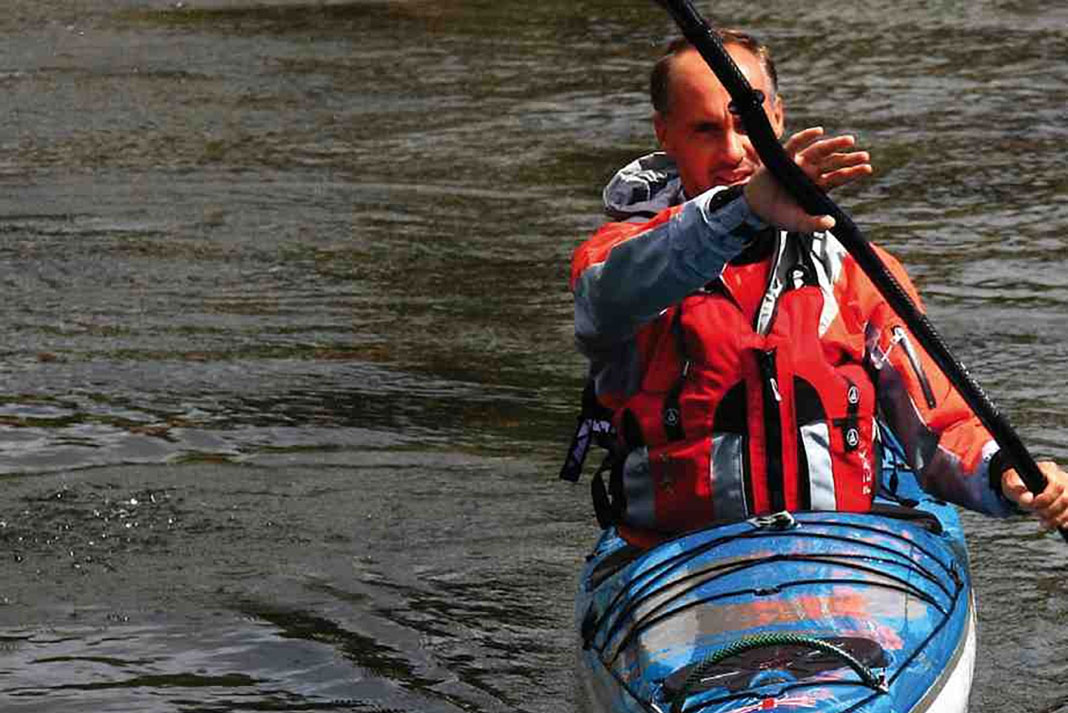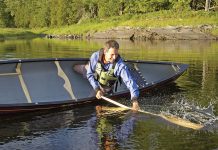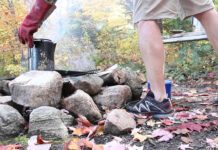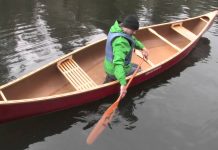Ninety-nine percent of the time you spend in your sea kayak is devoted to paddling forward. With a cadence of 50 full stroke cycles each minute, a paddler makes 3,000 strokes every hour. This means that small improvements in your kayak forward stroke technique add up to large improvements in overall progress.
Peer Review
“Think of torso rotation in three parts: an active phase, a passive phase and a pause. Thinking in these terms will help you avoid carrying the blade in the water beyond your hip, and help you plant the blade far enough forward.”– Nigel Foster, BCU level 5 coach, St. Petersburg, FL
“Rotation starts at the sit bones. Most paddlers lock their pelvis into a forward-only position during the forward stroke, rotating from just the belly button up. This doesn’t engage all of the core muscles. Use a slippery seat pan that allows your hips to slide when rotating.”
– Shawna Franklin, BCU level 4 coach, Orcas Island, WA
“During the catch phase, emphasize forward stroke expert and sprint coach Dan Henderson’s advice: Save the rotation. Make sure the blade is fully submerged before any body rotation begins. Too many paddlers rotate as they stab the paddle into the water, creating an air pocket that reduces power and efficiency.”
– Leon Sommé, BCU level 4 coach, Orcas Island, WA
“Check your rotation by watching your top hand during the power phase. This hand should maintain a consistent height across your kayak, as opposed to dropping down toward your deck.”
– Meaghan Hennessy, BCU level 3 coach and Paddle Canada level 2 instructor trainer, Vancouver, BC
Moving forward with a high-angle stroke
Stroke technique isn’t just about going faster. A more efficient stroke might propel you at the same speed, but it will get you to the beach with less fatigue, muscle strain and joint pain, saving energy for those times when you need to paddle faster or longer.
The high angle forward stroke described here is one of the most recognised forms of forward paddling technique used on the sea. I do, however, encourage every paddler to develop a variety of forward paddling styles; this enables adaptations to be made for environmental conditions.
High angle is the most efficient forward paddling style. It gives you maximum speed in your sea kayak and, when done well, maximizes the use of your larger body muscle groups. However, it requires good posture, balance, body rotation and appropriately conditioned muscle groups for comfortable paddling day in, day out.
How to complete a kayak forward stroke
1) Catch Phase
- Body posture upright with no forward bobbing.
- Arm extended for maximum reach.
- Relaxed top hand prevents wrist strain, improves circulation and reach.
- Maximum reach gained through good torso rotation.
- Paddle entering water cleanly and near vertical, like spearing a fish.
- Power put on paddle immediately.
2) Power Phase
- Unwind rotation of body for power.
- Push foot peg on the same side as paddle blade for power transfer through core muscles.
- Knees/thighs relaxed in kayak to allow power transfer.
- Paddle stays at a high angle so the blade tracks near vertically alongside the kayak.
- Paddle is held away from body throughout to maximize rotation.
- Top hand guides and pushes paddle to prepare for next catch phase and stays about level with eyes.
3) Blade Exit
- Blade exits at or just before hip.
- As blade exits it is sliced out with no scooping of water.
- Top hand is high and body is in position for final rotation for the next catch.

Final tip for the kayak forward stroke
Many kayakers hold their paddles too close to their bodies when performing forward strokes, preventing full rotation and control. Pretend you have a beach ball between you and your paddle to avoid your paddle coming too close.
Happy paddling!
Feature Video: Paddle farther with less effort. James Roberts and Dympna Hayes of Parry Sound’s Ontario Sea Kayak Centre share their top tips for going the distance without getting tired.









Why is there no mention of reducing the unpowered interval called “recovery”, during which the energy spent in the completed stroke resulting in a given hull speed is lost as the kayak slows. The longer the recovery the greater the loss of hull speed that must be recovered in every subsequent stroke. When I am out for a long day and I focus on “snapping” the paddle from finished stroke to the catch of the next, (shortening that period of time when neither blade is in the water and the kayak’s momentum and hull speed are quickly decreasing) I find that the required effort to maintain hull speed is much reduced and endurance is greatly enhanced. Think of it this way: If you could accurately graph hull speed over time, the effect of each paddle stroke would create a wave shaped line in which each power stroke would be followed by a fall-off in hull speed until the next catch applied forward power. And one could determine average hull speed as a flat horizontal line. Max hull speed would be graphed as the peak of each wave corresponding to the end of each forward stroke. The drop in hull speed from the peak to the average speed line would need to be recovered in the next stroke. So every unnecessary millisecond spent in recovery between power strokes results in wasted energy spent recovering the speed/momentum lost during recovery. Once a flicking movement of the paddle is mastered (both ends are moving quickly through air, not water), the energy savings are dramatic and each stroke requires less power to achieve the same average hull speed, thus flattening the graph. All I can say is try it! I am confounded that competitive rowing sports have not embraced this thinking yet.